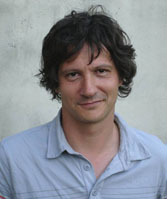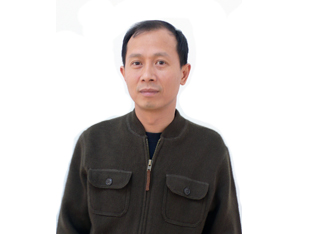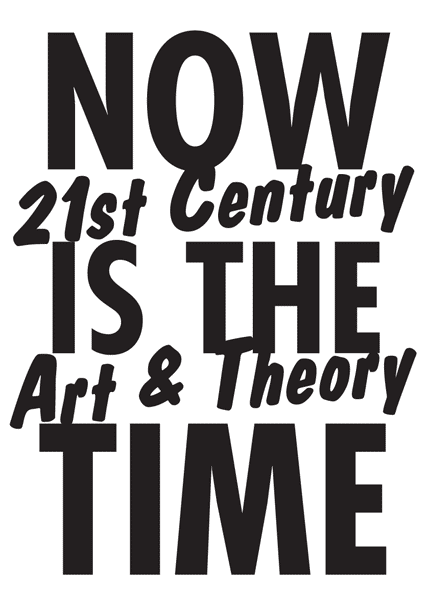Event: Now is the Time, Globalisation. How To Resist Through Art
On Tuesday November 11 the third lecture in the series ‘Now is the Time’ [1] was held in Amsterdam. The topic is Globalisation and the effect on art itself. Questions addressed are: Do increased mobility and intercultural exchange lead to a ‘global art vernacular’, a new mainstream in which differences in aesthetic appearance or thematic content have been reduced to a minimum, regardless of the geographical or cultural provenance of a work of art? What about critical countermovements: can art provide an effective platform for these alternative voices? The two key speakers are Julian Stallabrass [2] and Hou Hanru [3].
 Julian Stallabrass resists spectacle
Julian Stallabrass resists spectacle
According to Stallabrass, our life is rather regulated (even leisure time gets scheduled in), massculture reflects this by talking about passion and breaking the rules (popmusic as compensation). Art, on the contrary, doesn’t fit in because it stands autonomously (to the creator and to the public), it doesn’t apply to either work or massculture, for there are no market pressures, it is not tested against mass taste and is not mass produced.
Globalisation is aligned to neoliberalism, old securities are diminished, national economies are thrown open to worldwide economies and lead to ‘national erosion’. The globe becomes a mega playground for the rich (freer circulation of money). A relative decline is visible for the US as new (art) worlds increase, 5 times as much auction revenue in Indian art and ¾ of the top artists are Chinese as seen in auction sales in 2007.
Every year there are more biennials organized around the globe, the virtues of this movement are, mixing, mobility, cross influences etc. But more importantly they are all attacking fixed values and ideas, they are anti-colonial, anti-holocaust and anti-national attachments. The world becomes supernational (above national).
There is a tension between cultural and economic movements. The titels (themes) of the biennials are deliberately hiding things, ‘made up’, Berlin: infinitably expendable theme and ‘Tales, Time, Space’, Folkestone: says everything. The motto seems to be: “just take up space, don’t do anything.” You can say this about art as well. Fredric Jameson states that cultures and art works are cursed for they can only be seen as allegory of the nation, which is now an allegory of globalisation. The hidden ideology being the promise of mutual ideas and multicultural utopia’s, these become the ideals of biennials as well.
There are some elements that undermine this hype for instance you can map the missing nations form a biennial. The benefits of this opposition are: 1. it transcends ordinary entertainment to something more universal 2. it is not propaganda to simple globalisation.
An important notion of globalisation was the fact that the rich get richer and the poor get poorer (Gini coefficient 1947-2005).
Reasons for buying art:
1) The rich are buying in to global art clubs, they buy access into intellectual discourse. The art works themselves seize to ‘work’ since they are made exclusive (performances and multimedia installations only performed at exclusive opening parties for instance).
2) The rich are buying art for spreading risk. Hedge funds are promoting young artists (cheap) and by doing so manipulate the prices by creating a ‘bubble’ (made expensive).
After 9/11 multiculturalism came under attack. It’s important that you can’t be too different, ‘others’ became the people ‘you can’t talk to’. But also ‘we’ became unrecognizable (pictures of western soldiers in Abu Graib).
The idea of Stallabrass for an anti-biennial is to conflict ‘the images of war’ with ‘the war of images’. The display of the works would cause a mediation of war, through building a narrative with visual arguments. The danger of oppositional art, though, is that since art is non-instrumental (separate from every day life) it could loose its art life character. But resistant art questions the fundaments of art by creating art that reveals this position. Art has to resist spectacular globalisation.
 Hou Hanru’s mission against changefication
Hou Hanru’s mission against changefication
The centre of the globe has been New York but now other cities claim this position. As an example Hanru shows images of the opening of the Olympics in Beijing, 2008. The fireworks cost 2 billion dollar but nobody complained because everybody was happy. But there were some remarkable things happening: Computed fireworks (only virtually seen through television sets all over the world, but not in the ‘real’ sky), a girl lip-syncing (and an uglier girl singing behind a curtain), 56 Chinese ethnic groups presented by only Han (the dominant ethnic group) children in costumes etc. The virtual image (the way you present yourself) becomes more important than the real image. You can also see that in the way architecture has become one of the prominent art forms of this century. The visual imagery accompanying architecture are very appealing virtually.
It becomes increasingly hard to create a spectacle in a global world. Architecture is a good way of achieving this for it produces spectacular space (a totally new urbanity). China recognizes that computers are important for ‘space making’ (architecture and urbanization), they see the power of ‘the virtual image’. A company called Cristal Digital [4] are making the visuals for big architecture companies and influence decision making by presenting a dream. A competition of spectacle has arrived, every city wants to be the most ambitious and innovative one. Others are responding through architecture (scale and height). The price that has to be paid for this competition is green land that was supposed to be for public space. Because of the need for isolation to meet the royal status of the high-rises, the green becomes inaccessible (only for the eye to see from a window in the high-rise).
Resistance has started to reclaim public space. An example are ‘nail families’[5], in China, living in houses in the middle of construction sites unwilling to leave, forcing governments to face the reality. From a communist perspective the government has to accept the fact that they cannot favour private property (the development project) and ignore public interest, otherwise the next step will be revolution.
This is where art comes in. You need artistic skill or curatorial skill to do something with this data of resistance. An example is the story of the government acting out the changefication of the city for the Olympics by claiming back abandoned areas for global tourism. Demolition started and some people refused to leave the site. An artist gave one of the inhabitants a camera and this stopped the demolition for China couldn’t afford to lose face on global television. This shows the importance of images.
For Hanru the task for artists and curators is to defend community interests. Artists can research urban conditions and theorists can also research art along the lines of these kind of negotiations. Important notion of this time is to resist changefication.
New media notions
The new media notions of this evening were Stallabrass’ ideas on the ‘mediation of war’ for his anti-biennial and Hanru’s ideas about the power of virtual images in a new global competition for urbanisation and producing spectacular space.
[1] ‘Now is the Time’ is a collaboration between Stedelijk Museum Amsterdam, University of Amsterdam, W139, Stedelijk Museum Bureau Amsterdam and Metropolis M aiming to stimulate the study of visual arts of the present day and recent history, and promoting a dialogue between both art theory and art practice, and art and society at large.
[2] Julian Stallabrass (UK) is reader in Art History at the Courtauld Institute of Art. London. Author of several books amongst others Art Incorporated (2004).
[3] Hou Hanru (CHN/US) is a curator and art critic, best known for exhibitions that critically engage with migration, urbanisation, and modernisation in the era of globalisation for example the Istanbul Biennial (2007).
[4] http://www.crystalcg.com/en/index.aspx
[5] http://app1.chinadaily.com.cn/star/2002/0703/fo4-1.html
